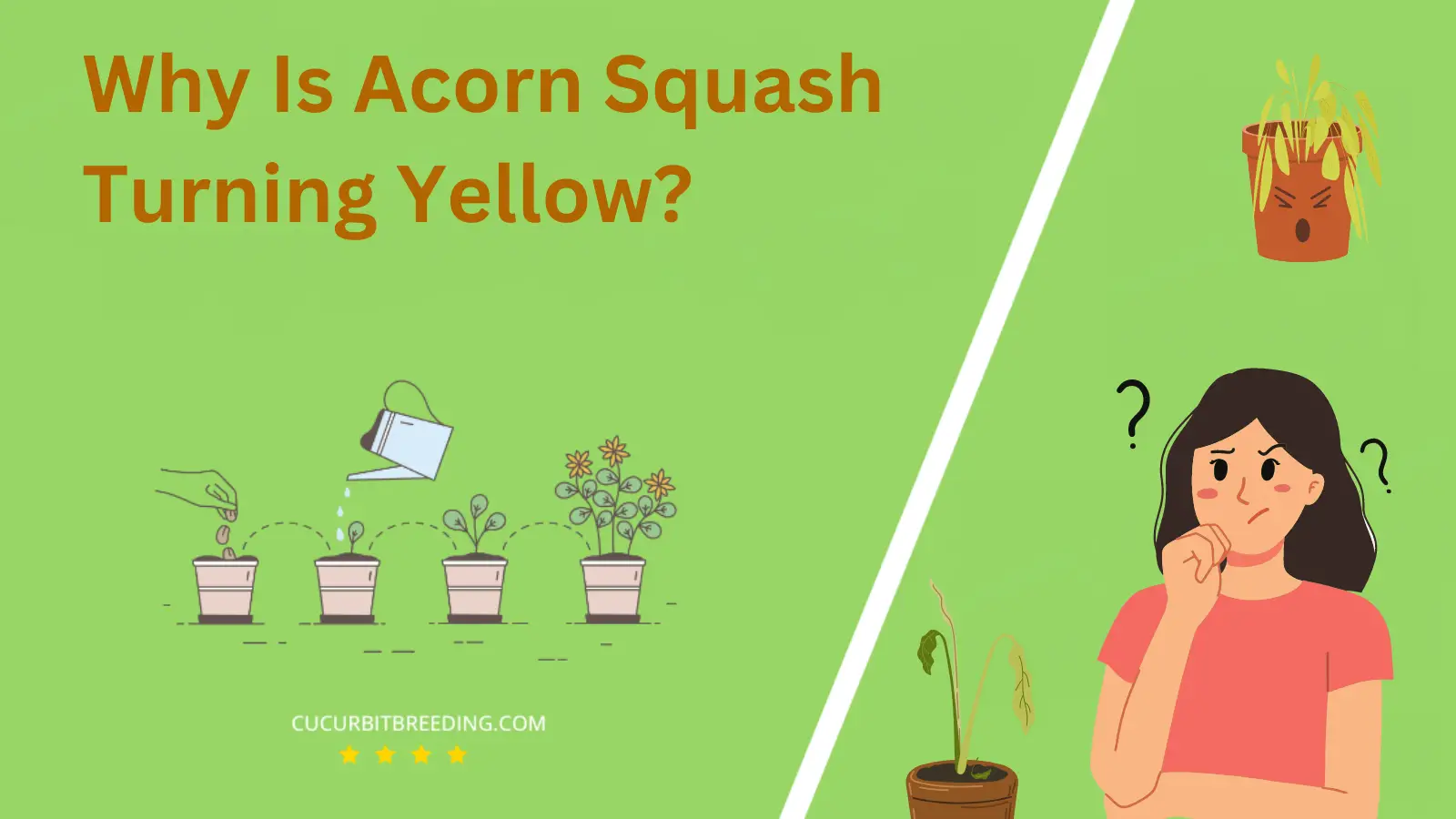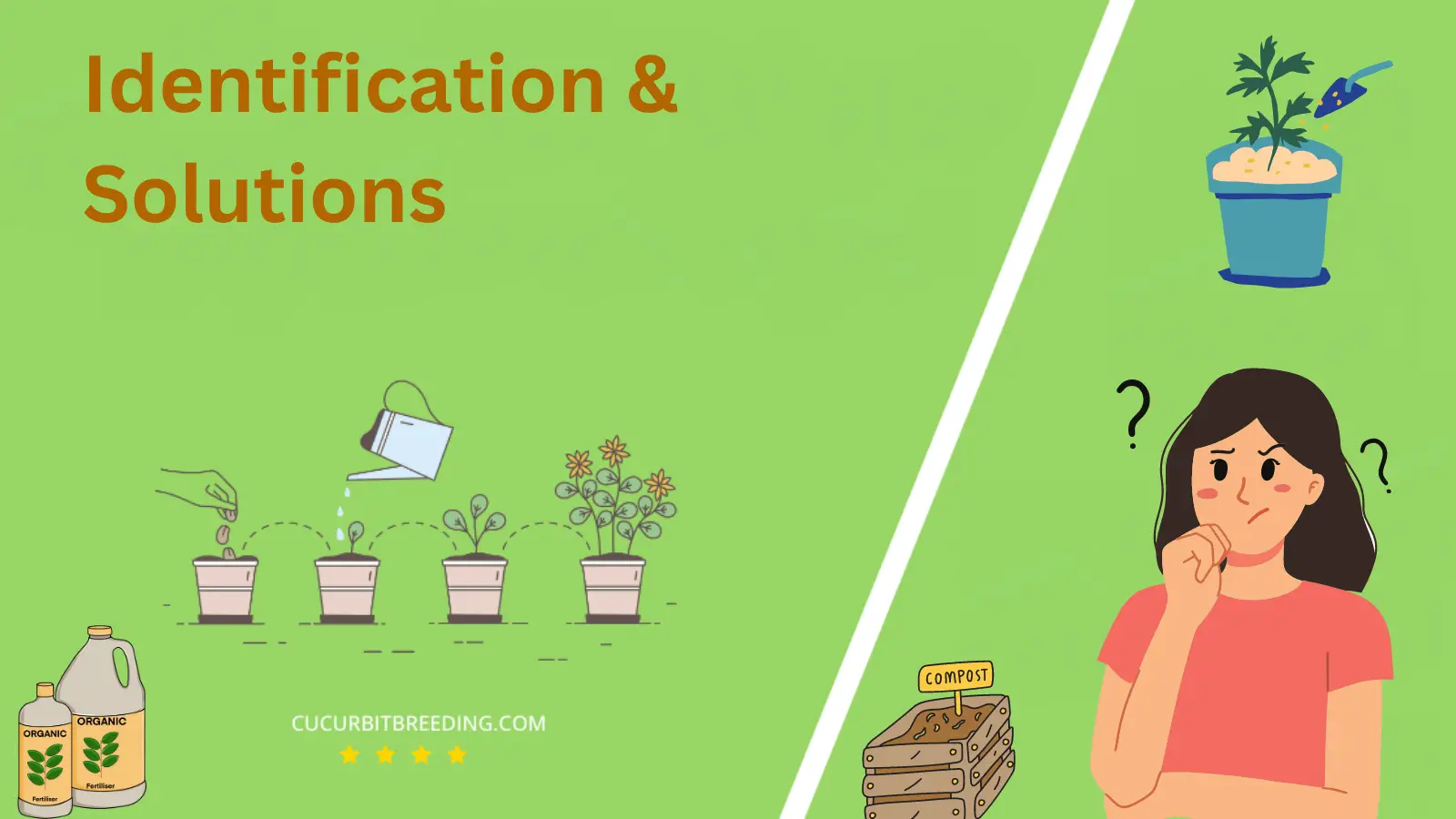
Ever noticed your acorn squash turning yellow and found yourself confused by this unexpected color change? While acorn squash, renowned for its deep green skin, is a delight of many gardeners, it can often present the puzzling phenomenon of a yellow transformation.
Before you panic or question your green thumb, realize that there might be a range of factors triggering this squash metamorphosis. The suspenseful thrill of gardening – the unpredictable turns, trials, and triumphs – is just beginning.
Why Is Acorn Squash Turning Yellow?
1. Overripe or mature stage
| Description | Overripe or mature stage causes yellowing of leaves due to natural aging and chlorophyll breakdown. |
|---|---|
| Solution | Harvest acorn squash before maturity to prevent yellowing. |
Reason: Overripe or Mature Stage
Effects: An acorn squash typically has a green exterior while it’s still in its growth stage, but as it matures, it begins to turn a darker, deeper green. However, when the squash has reached and passed its prime ripeness or mature stage, it starts to turn yellow. This is completely natural and usually indicates that the squash has been left on the vine for too long. This overripeness is not necessarily bad for the squash, but it might not taste as sweet or have as desirable a texture as properly ripened squash.
Solutions: To avoid having your acorn squash turn yellow, you should monitor its growth carefully. Acorn squash typically matures after about 80 to 100 days of growth, and its skin becomes harder and its color changes to darker green. Once it reaches this stage, you should harvest it to prevent overripening. Simply cut the squash off the vine, leaving about an inch of the stem attached. If the squash has already turned yellow, it is still edible but the taste and texture may vary, also, sunlight exposure should be controlled. Make sure it’s properly stored in a cool, dry place to prevent further ripening or eventual rotting.
2. Lack of sunlight
| Description | causes a decrease in chlorophyll production, leading to yellowing of the leaf. |
|---|---|
| Solution | Increase exposure to sunlight through proper positioning or using artificial grow lights. |
Acorn squash can turn yellow due to a lack of sunlight. Just like most other plants, acorn squash relies heavily on photosynthesis to produce energy for growth. In the process of photosynthesis, plants convert solar energy into chemical energy. Without enough sunlight, the plant can’t produce sufficient chlorophyll, leading to yellowing of the leaves, also known as chlorosis.
To rectify this issue, you should consider relocating your acorn squash plant to an area that receives more sunlight. Ideally, it should have access to a minimum of six hours of direct sunlight daily. If providing natural light isn’t a feasible option, grow lights can act as a decent substitute. These lights emit a spectrum of light suitable for photosynthesis. Adjust the brightness and duration of light exposure based on the plant’s requirements.
Also, keep in mind that you should avoid sudden changes in light exposure, as this might stress the plant. Gradually increase the plant’s exposure to light over a few days if it was previously growing in a low-light condition.
3. Nutrient deficiency
| Description | The acorn squash turns yellow due to nutrient deficiency, affecting its physiological processes. |
|---|---|
| Solution | Provide a balanced fertilizer to correct nutrient deficiency and prevent acorn squash from turning yellow. |
Acorn squash turning yellow may be due to a nutrient deficiency, particularly a lack of nitrogen in the soil. Plants use nitrogen for making vital molecules such as chlorophyll, which is necessary for photosynthesis and gives leaves their green color. Without sufficient nitrogen, your acorn squash might lose its vibrant green hue and turn yellow.
Assessing Soil Nutrients:
To verify if nutrient deficiency is the issue, you could consider having a soil test conducted. This will provide details about the current nutrient levels in your garden and suggest any adjustments required.
Addressing Nutrient Deficiency:
In case of a nitrogen deficiency, you could enrich your soil with compost or a nitrogen-rich fertilizer. It’s important to apply these amendments according to package directions or soil test recommendations.
Maintenance:
Regularly monitoring plant health and soil conditions can help in early detection of any deficiencies. Balanced feeding and watering practices will also ensure a healthier growth of your acorn squash plants.
4. Pest or disease infestation
| Description | The acorn squash turns yellow due to nutrient deficiency, affecting its physiological processes. |
|---|---|
| Solution | Provide a balanced fertilizer to correct nutrient deficiency and prevent acorn squash from turning yellow. |
Pests or diseases can lead to yellowing of acorn squash. When infected with diseases such as bacterial wilt or squash bugs, the plant’s normal functions are disrupted, causing its parts (including fruit like acorn squash) to turn yellow. This is because the infection usually blocks the plant’s vascular system, disrupting the transportation of nutrients and water, thereby leading to chlorosis – a condition that causes the green parts of a plant to turn yellow.
The first step to rectify this issue is identifying the specific pest or disease causing the yellowing. Once identified, you can use targeted treatment tactics. For squashes affected by bacterial wilt, unfortunately, there is no cure and removal of the infected plant is recommended to prevent the disease from spreading. But for those infected by squash bugs, using pest control methods like insecticides, handpicking bugs off the plants or planting bug-resistant varieties could help get rid of them.
Always remember to monitor your garden regularly for any signs of pests or disease. Early detection and action could potentially save your acorn squash from fatal damage.

5. Inadequate watering or irrigation
| Description | Provide a balanced fertilizer to correct nutrient deficiency and prevent acorn squash from turning yellow. |
|---|---|
| Solution | Increase watering or irrigation to prevent acorn squash from turning yellow. |
When acorn squash is subject to inadequate watering or irrigation, it becomes stressed and its typical green, healthy color can fade to yellow. This is because proper watering is crucial for the transfer of nutrients within the plant and moistening the soil in which the squash grows. Improper watering can cause the plant to be thirsty and push it into survival mode, leading to yellowing.
The main solution here is scrutinizing and adjusting your watering regimen. Acorn squash thrives best when they receive about an inch of water per week. To achieve this, it’s helpful to use soaker hoses or other forms of trickle irrigation, which enables the water to penetrate deeply into the soil, reaching the plant’s root system. It’s best to water early in the morning or late in the evening when evaporation is minimal. In addition to improving watering, consider amending the soil with organic material such as compost or well-rotted manure, which can aid in its water-holding capacity.
6. Environmental stress (such as extreme temperatures)
| Description | can disrupt chlorophyll production, causing leaves to turn yellow. |
|---|---|
| Solution | Provide consistent watering and ensure proper sunlight exposure to prevent acorn squash from turning yellow. |
Acorn squash turning yellow can be a direct result of environmental stress, particularly extreme temperatures. Plants are very sensitive to their surrounding conditions, and squash plants are no exception. Extreme temperatures can stress the plant, causing it to shift energy and resources away from normal functions, such as maintaining a healthy green color.
This is often characterized by a yellowing of the leaves and, in severe cases, the squash itself. High temperatures can cause water to evaporate more quickly from the leaves and soil, depriving the squash of necessary hydration. On the other hand, very low temperatures can freeze the plant’s cells, impeding its ability to carry out vital functions such as photosynthesis, thus leading to yellowing.
To combat this, make certain that your squash plants are in an area with suitable temperatures – typically between 50°F and 95°F. It may be helpful to relocate the plants if they’re currently in a location that receives extreme temperatures recurrently. Furthermore, for hot climates, frequent and deep watering can help keep the squash adequately hydrated. For colder climates, using mulch or row covers can help keep the soil warm and protect the squash plants from frost.
7. Genetic factors
| Description | Genetic factors can cause the leaf to turn yellow due to altered physiological processes. |
|---|---|
| Solution | Identify and modify genetic factors through selective breeding or genetic engineering techniques. |
The reason why your Acorn Squash is turning yellow might be due to a nutrient deficiency, particularly Nitrogen. When Nitrogen levels are too low, squash plants will turn yellow because this critical nutrient helps in producing chlorophyll, the pigment that gives plants their green color. Without enough Nitrogen, the plant can’t produce enough chlorophyll, leading to yellow leaves.
To rectify this problem, consider supplementing your soil with a balanced organic fertilizer or a high-Nitrogen fertilizer. It’s also important to ensure your plants are watered properly and get the right amount of sunlight to enhance nutrient uptake. Regular soil tests can help identify nutrient deficiencies early on, enabling you to adjust your nurturing practice accordingly and prevent your squash from turning yellow.